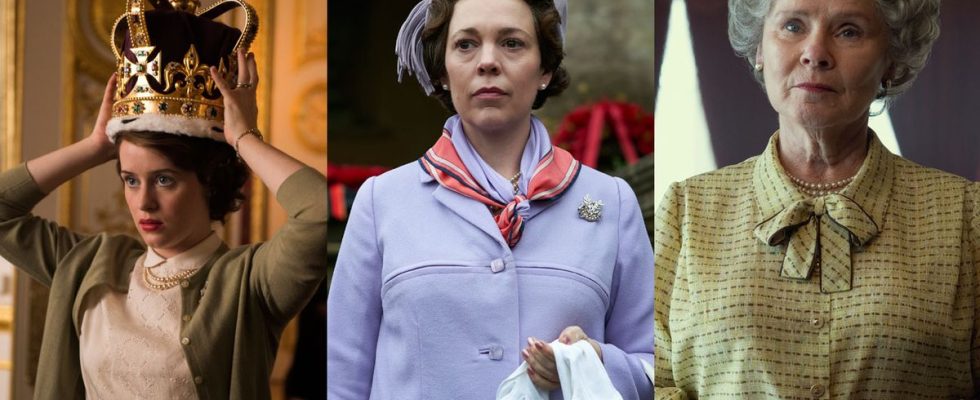It’s time to say goodbye to the Queen. This Thursday, Netflix is releasing the first episodes of the final season of The Crown, the series which traces the reign of Elizabeth II. This very last chapter opens with the tragic disappearance of Lady Di and should end in the mid-2000s. “As she prepares to celebrate her golden jubilee, the queen reflects on the future of the monarchy facing the upcoming wedding of Charles and Camilla and the royal romance of William and Kate,” describes Netflix in its synopsis.
Since the 5th season, it is Imelda Staunton who has played the sovereign and the slump she went through during the 1990s. Before her, two other actresses played the role of Elizabeth II: Claire Foy for the beginning of her reign then Olivia Colman in the Thatcher era. Vulnerability, harshness, diplomacy… Each actress revealed different facets of the life and personality of the Queen of England. The culture department of 20 minutes looks at what each made us love about the Queen (or come out through the noses).
Coronation and upheaval: Claire Foy and romanticism
Claire Foy lends her face to the first two seasons of the series. Through her, the public discovers an unsuspected side of the heir to the English throne, that of a romantic and deeply human young princess. Reserved, devoted and above all madly in love with Philip, whom she has succeeded in establishing as her future husband, she prepares to sacrifice her life: accession to the throne. Added to the weight of the title of Royal Highness is that of one’s family, which can quickly become a burden. The crown forces Elizabeth II to step aside behind her official functions, even if it means forgetting her part of humanity and erasing her role as wife, sister and mother.
Claire Foy embodies a fascinating pivotal era in the history of the British royal family: the start of a reign that would last seventy years. Following in Elizabeth’s footsteps, the viewer enters the golden prison of Windsor Castle and becomes aware of the extreme rigidity of its rules. Remember that originally, neither she nor King George VI should have acceded to the throne. After a year of reign, Edward VIII, his father’s eldest, renounced the crown by choosing to marry a twice-divorced American socialite, at the same time shedding his responsibilities. Through these two brilliant seasons, Princess Elizabeth learns the hard way that by wearing the crown, she will never belong to herself again. The Queen’s emotion and vulnerability will no longer appear as evident.
Coldness and disconnection: the Thatcher years and Olivia Colman
At the very end of season 2, we leave a Queen of England who is emotionally shaky (she has been trying to digest the rumors about Philip’s infidelities for several years) and pregnant with her 4th child, Edward. We find her again a few months later at the very beginning of season 3, but with a major change: Olivia Colman takes over the torch from Claire Foy. Gone is the reserved and fragile young monarch, The Crown then depicts an impassive and distant sovereign, who suffers intimately from her unpopularity in the face of her adored and completely crazy younger sister.
Icy, Olivia Colman breathes such coldness into her character that we quickly become nostalgic for young Elizabeth, assailed by doubts and much more human from the beginning of the series. The 3rd episode of the season particularly crystallizes this feeling. He is intitulated Aberfan, named after this town in Wales where the collapse of a slag heap in 1966 caused 144 victims, including 116 children. A drama that moved an entire country, its political class and members of the royal family… With the exception of Elizabeth, at least in appearance. Insensitivity? Modesty ? It is difficult to fathom this imperturbable face of a queen who is gradually distancing herself from her people in this second half of the 20th century. Also note the fascinating game of mirrors that arises between her and Prime Minister Margaret Thatcher, played by Gillian Anderson, during season 4.
The picture is no better within the royal family itself. Olivia Colman plays a queen who is completely out of her depth, especially in her relationship with her children. We remember this lunar episode (Favorites) where the queen organizes individual meetings with her daughter and her three sons in order to understand which child she prefers. Over the course of these two seasons, led by Olivia Colman, the series paints the portrait of an increasingly isolated queen, frozen in her small, narrow world disconnected from reality.
Wisdom and blindness: Diana and Imelda Staunton
Without denying the immense talent of Claire Foy and Olivia Coleman, it must be admitted that the first two interpreters of Elizabeth II had it easy. The young ingenue who discovers her role, then the experienced but injured queen, ok, we understand… Third and final interpreter of the queen, Imelda Staunton faced a role that was much more thankless and difficult to embody. The Elizabeth of the Diana years, that of the annus horribilis, of the bland John Major years. In short, the years when the British royal family aroused, at best, polite disinterest, at worst, frank hatred.
Far from leaving all the glory and light to the character of Diana on the brink of the abyss, Imelda Staunton plays a queen at the height of blindness when it comes to understanding what is happening in her country or her family. , and perfectly at peace with its institutional role. It’s less sexy than the young queen in distress or the forty-something in crisis, but it’s upsetting to watch.

